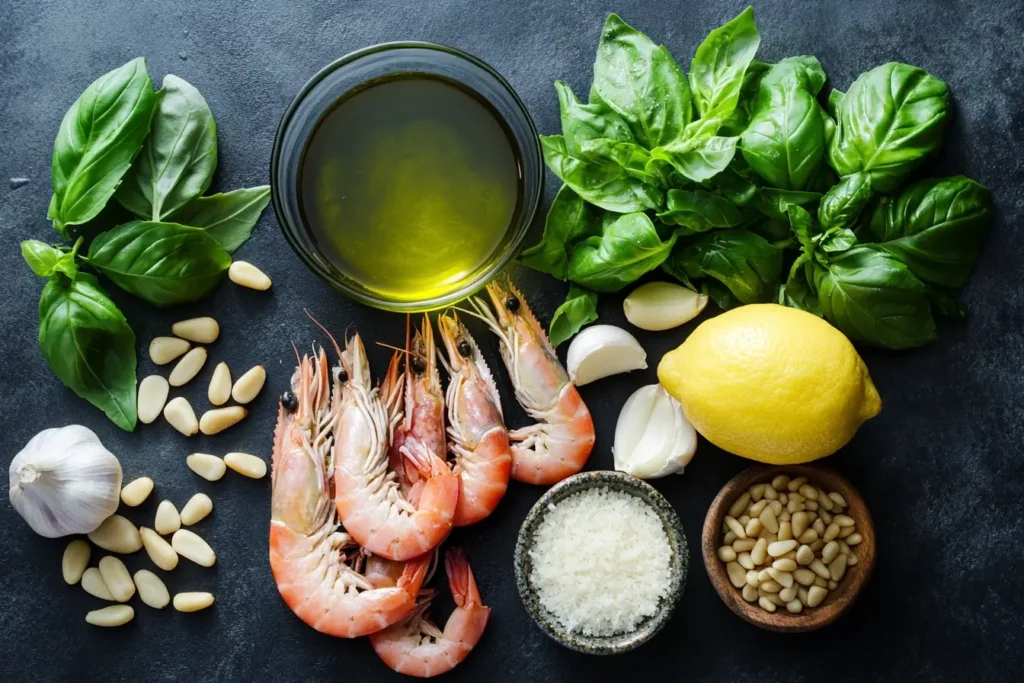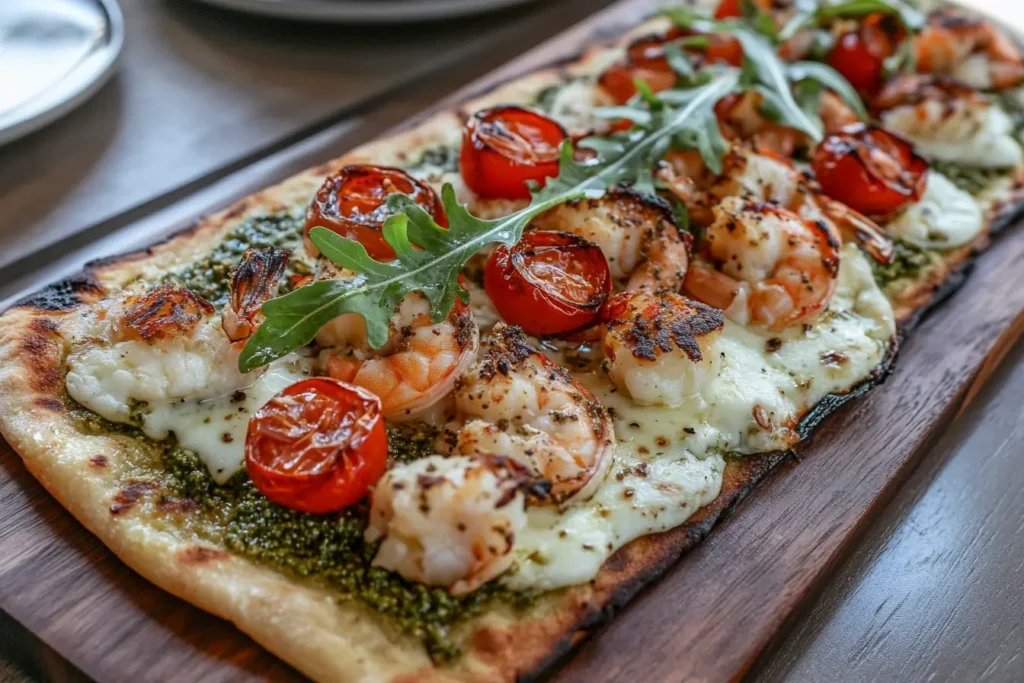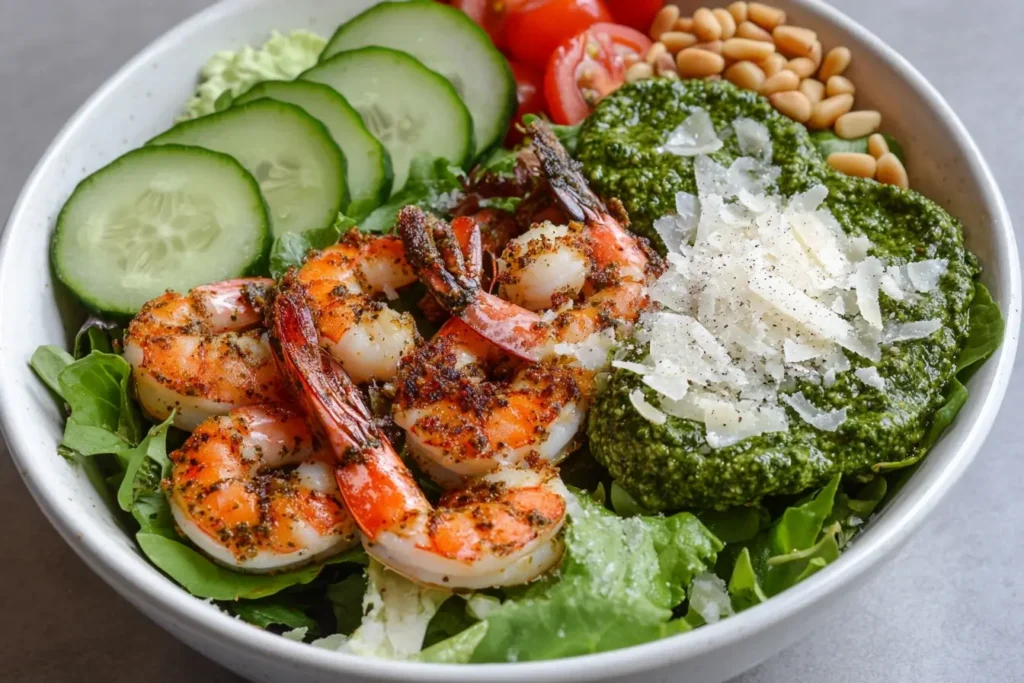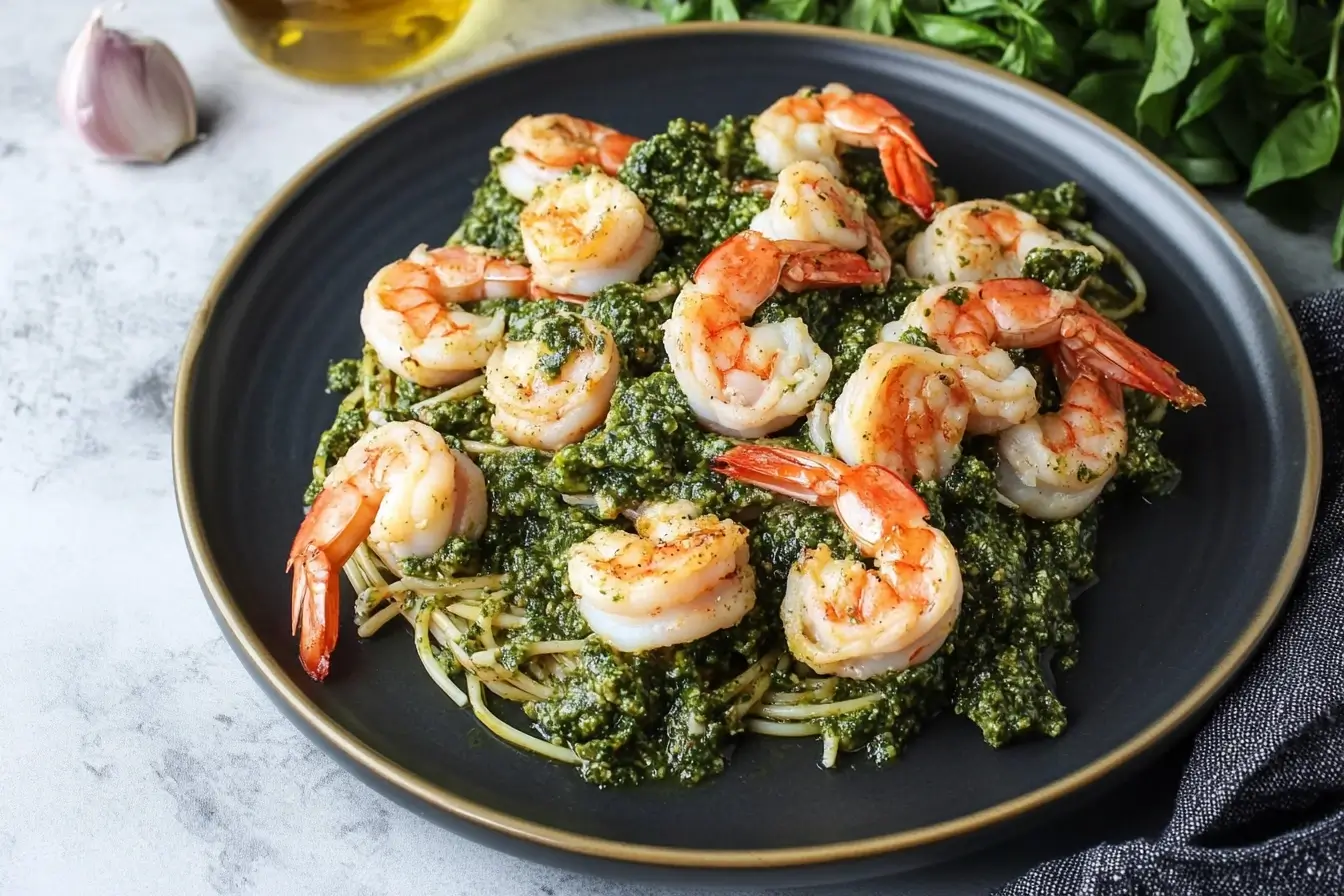Langostinos paired with the rich and fresh flavors of pesto sauce create an amazing dining experience. Whether you’re an experienced chef or just love to cook at home, these pesto langostino recipes are a great way to take your cooking to the next level. In this guide, we’ll look at what makes langostinos special, explore the world of pesto, and share simple steps to create delicious pesto langostino dishes.
Ready to learn how to make these crowd-pleasing recipes? Let’s get started!
What Are Langostinos?
Langostinos are often mistaken for shrimp or lobster, but they have their own special place in cooking. From their origins to their mild and sweet flavor, langostinos add elegance and versatility to many dishes.
Understanding Langostinos (Origins, Flavor Profile, and Differences)
Langostinos, also known as squat lobsters, are small shellfish typically found in cold waters. While they look like lobsters, they are not true lobsters. These shellfish have a tender, sweet, and mild taste, similar to a mix of shrimp and lobster.
One main difference is their texture—langostinos are softer and more delicate than shrimp but not as firm as lobster. This makes them perfect for recipes where the protein adds flavor without taking over the dish.
Langostinos are commonly used in Mediterranean and South American cooking, with Chile being a leading supplier. Since they soak up flavors well, they are a favorite choice for seafood stews, pasta, and salads.
Nutritional Benefits of Langostinos
Langostinos aren’t just a delicious indulgence—they’re also packed with nutrition. High in protein and low in fat, they are an excellent choice for those aiming to maintain a balanced diet. A 3-ounce serving of langostinos provides approximately:
- 15 grams of protein
- Less than 1 gram of fat
- A significant amount of omega-3 fatty acids, beneficial for heart and brain health.
They are also rich in essential vitamins and minerals like selenium, vitamin B12, and phosphorus, which support metabolism, immunity, and bone health. This nutritional profile makes langostinos a guilt-free addition to any gourmet recipe.
Popular Uses in Culinary Dishes
Langostinos are incredibly versatile, making them a great choice for many different recipes. For example, their tender and sweet flavor works well in seafood pastas, where they go perfectly with creamy or tomato-based sauces.
In addition, they make great appetizers, often used in ceviches or served with tasty dipping sauces. Their delicate flavor also improves broths and stocks, making them a key ingredient in soups and stews without overpowering other flavors.
Furthermore, their mild sweetness pairs well with fresh greens and citrus dressings, making langostinos a popular choice for salads. As a result, they bring both texture and flavor to light and refreshing dishes.
In short, langostinos are a hidden treasure in the world of cooking, giving chefs and home cooks endless ways to create and improve their meals.
An Overview of Pesto Sauce
Pesto is a classic sauce loved by food enthusiasts everywhere. Its rich, fresh flavor and smooth texture make it a versatile addition to many dishes. Pairing pesto with langostinos is a natural fit, as the sauce highlights the sweet, delicate flavor of the seafood while adding depth to the dish.
Traditional Ingredients of Pesto
Authentic pesto, also known as pesto alla Genovese, originates from the Liguria region of Italy. The word pesto comes from the Italian verb pestare, which means “to crush” or “to pound.” Traditional pesto is prepared using a mortar and pestle, though modern methods often involve a food processor.
The core ingredients of pesto include:
- Basil: Fresh basil leaves provide the sauce’s signature green hue and aromatic flavor.
- Pine nuts: These small nuts lend a creamy texture and subtle nuttiness to the sauce.
- Parmesan cheese: Adds umami and richness.
- Extra-virgin olive oil: Ensures a silky texture and enhances the overall taste.
- Garlic: Adds a sharp, pungent bite.
- Salt: Balances the flavors.
These simple yet powerful ingredients combine to create a sauce that is both earthy and vibrant, perfect for enhancing the natural sweetness of langostinos.
Variations of Pesto
While the traditional recipe remains iconic, chefs and home cooks have experimented with countless pesto variations. These adaptations allow you to tailor the sauce to your taste preferences or dietary needs. Popular alternatives include:
- Spinach pesto: A milder option that swaps basil for spinach.
- Kale pesto: A nutrient-dense twist that retains the signature green color.
- Sun-dried tomato pesto: Offers a tangy, sweet, and slightly smoky flavor profile.
- Vegan pesto: Uses nutritional yeast instead of Parmesan for a dairy-free alternative.
- Nut-free pesto: Swaps pine nuts for sunflower seeds or omits them entirely.
Experimenting with these variations can result in unique flavor combinations that complement langostino dishes in surprising and delightful ways.
The Perfect Pairing: Why Pesto Works with Langostinos
Pesto’s bright and fresh flavor is a perfect match for the mild, sweet taste of langostinos. The rich sauce balances the soft texture of langostinos, while its tangy notes keep the dish light and flavorful.
This pairing is also very versatile, letting you try different dishes, such as:
- Pasta dishes: Mix langostinos and pesto with freshly cooked pasta for a quick and tasty meal.
- Flatbreads and pizzas: Use pesto as a base and add langostinos for a Mediterranean twist.
- Salads: Drizzle pesto over a langostino and mixed greens salad for a light, refreshing option.
By combining these two ingredients, you can make dishes that are simple yet satisfying.
Essential Ingredients for Pesto Langostino Recipes
The key to a great pesto langostino dish is using the best ingredients. Fresh, high-quality items will make every bite full of flavor. Whether you stick to a classic recipe or try something new, knowing the right ingredients is important.
Fresh Ingredients You’ll Need

For the best pesto langostino recipe, start with these fresh and simple basics:
- Langostinos: Choose fresh or frozen langostinos and clean them well. As a result, their sweet and tender meat will truly stand out in your recipe.
- Basil: Fresh basil leaves give your pesto a bright and bold taste. Without a doubt, it’s a must-have for any pesto langostino dish.
In short, by choosing top-quality ingredients, you’ll ensure your pesto langostino recipes are always delicious and satisfying.
Key Substitutions and Variations
Substitutions can cater to dietary needs or add a unique twist to your pesto langostino recipes. For instance, here are a few ideas:
- Greens: Use arugula or kale in your pesto to give your pesto langostino recipes a nutrient-rich upgrade. Additionally, these greens add a slightly different flavor for variety.
- Protein Variations: While langostinos are ideal, shrimp or scallops are also great alternatives in pesto langostino recipes. Similarly, you can even try grilled chicken for a heartier option.
Ultimately, experimenting with these ideas keeps your pesto langostino recipes fresh and exciting.
Cooking Techniques for Langostinos
Langostinos are a key ingredient in any pesto langostino recipe. Cooking them the right way ensures they stand out in your dish.
- Boiling: Once boiled, langostinos become soft and tender, making them perfect for mixing into your favorite pesto langostino recipes. This simple method helps bring out their mild flavor.
- Sautéing: Sautéed langostinos, with their lightly browned surface, are a great topping for pesto dishes like pasta or risotto. Cooking them this way also adds a touch of sweetness and a slightly crispy texture.
Using these methods will make sure your langostinos are prepared just right for any pesto recipe. These techniques also let you adjust the cooking style to match the dish you’re creating.
Top Pesto Langostino Recipes to Try
Pairing langostinos with pesto creates endless culinary possibilities. For example, they are excellent in comforting pastas and also shine in light, refreshing salads. Below, you’ll find some of the best pesto langostino recipes to inspire your next gourmet creation.
Classic Pesto Langostino Pasta Recipe
A quintessential dish, this recipe combines the tender sweetness of langostinos with the vibrant flavors of pesto sauce and perfectly cooked pasta.
Ingredients:
- 12 oz pasta (spaghetti, linguine, or fettuccine)
- 1 cup fresh pesto sauce
- 1 lb cooked langostinos, cleaned and deveined
- 1 tbsp olive oil
- 2 garlic cloves, minced
- 1/4 cup Parmesan cheese, grated
- Salt and pepper to taste
Instructions:
- Cook the pasta in salted boiling water until al dente. Reserve 1/2 cup of pasta water before draining.
- In a skillet, heat olive oil over medium heat and sauté the garlic until fragrant.
- Add the langostinos and cook for 1-2 minutes until warmed through.
- Reduce the heat and stir in the pesto sauce. If the sauce is too thick, add the reserved pasta water a little at a time to reach the desired consistency.
- Toss the cooked pasta with the pesto and langostinos. Season with salt and pepper.
- Serve hot, garnished with Parmesan cheese and fresh basil.
Creamy Pesto Langostino Risotto
For a decadent dish, this creamy risotto pairs perfectly with the rich flavors of pesto and succulent langostinos.
Ingredients:
- 1 cup Arborio rice
- 1/4 cup white wine
- 4 cups chicken or vegetable broth, warmed
- 1 cup langostinos, cooked
- 1/2 cup pesto sauce
- 1/4 cup heavy cream
- 2 tbsp butter
- 1/4 cup Parmesan cheese, grated
Instructions:
- In a large saucepan, melt butter over medium heat and toast the rice until lightly golden.
- Add the white wine, stirring until absorbed.
- Gradually add the warm broth, one ladle at a time, stirring frequently. Allow each addition to be absorbed before adding more.
- Once the rice is tender and creamy (about 18-20 minutes), stir in the pesto, cream, and Parmesan cheese.
- Gently fold in the langostinos and cook for another 1-2 minutes.
- Serve immediately, garnished with extra Parmesan and fresh herbs.
Langostino and Pesto Flatbread

This flatbread recipe is perfect for entertaining or a quick, gourmet-style dinner.
Ingredients:
- 1 store-bought or homemade flatbread
- 1/2 cup pesto sauce
- 1 cup cooked langostinos
- 1/2 cup mozzarella cheese, shredded
- 1/4 cup cherry tomatoes, halved
- Fresh arugula for garnish
Instructions:
- Preheat the oven to 400°F (200°C).
- Spread the pesto evenly over the flatbread.
- Top with langostinos, cherry tomatoes, and mozzarella cheese.
- Bake for 10-12 minutes, or until the cheese is melted and bubbly.
- Garnish with fresh arugula and serve immediately.
Pesto Langostino Salad with Fresh Greens

For a lighter option, this salad highlights the freshness of langostinos and pesto alongside crisp greens. In particular, it’s perfect for a refreshing lunch or an elegant appetizer at dinner parties.
Ingredients:
- 6 cups mixed greens (arugula, spinach, and romaine)
- 1 lb cooked langostinos
- 1/2 cup pesto (thinned with 1-2 tbsp olive oil or lemon juice)
- 1/4 cup cherry tomatoes, halved
- 1/4 cup cucumber slices
- 2 tbsp toasted pine nuts
- Shaved Parmesan for garnish
Instructions:
- Arrange the mixed greens, cherry tomatoes, cucumber, and langostinos in a large salad bowl. Meanwhile, prepare the pesto by thinning it with olive oil or lemon juice.
- Drizzle the pesto over the salad and toss gently to coat. As a result, every ingredient will be evenly flavored.
- Top with toasted pine nuts and shaved Parmesan. Finally, serve the salad chilled for the best flavor and presentation.
Cooking Tips for Perfect Pesto Langostino Dishes
Achieving perfection in your pesto langostino dishes is all about balance, technique, and presentation. Furthermore, using fresh, high-quality ingredients ensures that every element shines. Here are expert tips to ensure every recipe turns out as delicious as possible:
- Balance Flavors Thoughtfully:
- For example, pair the sweetness of langostinos with the brightness of lemon juice to keep the dish balanced.
- Master the Techniques:
- In addition, sautéing langostinos adds a caramelized exterior, enhancing their flavor. Similarly, boiling them ensures tenderness for chilled salads.
- Focus on Presentation:
- Meanwhile, use colorful ingredients like cherry tomatoes or cucumbers to make the dish visually appealing. As a result, the dish will not only taste great but also look gourmet.
Ultimately, following these tips will elevate your pesto langostino recipes and make them unforgettable.
Balancing Flavors (Acidic, Salty, Creamy Notes)
Pesto and langostinos both have distinct flavors, but achieving harmony between them is key.
- Acidity:
- Add a splash of lemon juice or a sprinkle of zest to brighten the dish. The acidity enhances the pesto’s herbaceous notes and complements the langostinos’ sweetness.
- Salt:
- Use just enough salt to highlight the flavors without overpowering them. If using Parmesan, which is naturally salty, taste the dish before adding extra salt.
- Creaminess:
- If your dish feels too sharp, balance it with creamy elements like a drizzle of cream, mascarpone, or a dollop of ricotta. This is particularly effective in pasta or risotto recipes.
Balancing these elements ensures that every bite is flavorful and satisfying without being overwhelming.
Avoiding Common Mistakes
To create restaurant-quality dishes, avoid these common pitfalls:
- Overcooking Langostinos:
- Langostinos cook very quickly. Overcooking can make them rubbery and dry. Always cook them briefly—just until they turn opaque.
- Overpowering Flavors:
- Pesto is a bold sauce, so use it sparingly to avoid overwhelming the delicate flavor of the langostinos. Start with a small amount and adjust as needed.
- Skipping Fresh Ingredients:
- Fresh ingredients are non-negotiable for pesto. Using wilted basil or pre-grated Parmesan can dull the flavor.
- Not Adjusting Consistency:
- If your pesto is too thick, thin it with pasta water, olive oil, or a touch of broth. This ensures it coats your dishes evenly without clumping.
By keeping these tips in mind, you’ll avoid common mistakes and elevate the quality of your dishes.
Presentation Tips for a Gourmet Touch
The way you present your dishes can transform a simple meal into a gourmet experience.
- Plate Artfully:
- Use white plates or flatware to make the green hues of the pesto and langostinos pop. Arrange the food neatly, allowing each element to shine.
- Garnish Thoughtfully:
- Add a sprinkle of freshly grated Parmesan, a few basil leaves, or a drizzle of olive oil for a polished look. Toasted pine nuts also add a sophisticated finishing touch.
- Color Contrast:
- Incorporate colorful vegetables, such as cherry tomatoes or roasted bell peppers, to provide visual appeal and enhance the dish’s overall aesthetic.
- Portion Elegantly:
- Avoid overcrowding the plate. Smaller portions arranged artfully make the dish look more refined and inviting.
A beautifully presented plate will not only taste better but also impress your guests or diners.
Cooking Tips for Perfect Pesto Langostino Dishes
Crafting the perfect pesto langostino dish requires attention to detail and a balance of flavors. These cooking tips will help ensure your meals are not only delicious but also beautifully presented.
Balancing Flavors (Acidic, Salty, Creamy Notes)
Acidity:
A squeeze of lemon juice or a splash of white wine can brighten the dish, cutting through the richness of the pesto. In contrast, vinegars, such as balsamic or white wine vinegar, can add depth without overpowering other flavors.
Saltiness:
Remember that Parmesan, pesto, and even langostinos themselves are naturally salty. Therefore, it’s important to taste before adding extra salt to avoid over-seasoning the dish.
Creaminess:
If you prefer a creamier texture, incorporate heavy cream, mascarpone cheese, or even Greek yogurt into the sauce. As a result, these additions create a luxurious mouthfeel without diminishing the vibrant pesto flavors.
Ultimately, striking the right balance ensures a harmonious dish where all elements shine without one overpowering the other.
Avoiding Common Mistakes
Overcooking Langostinos:
Langostinos are delicate and cook very quickly. However, overcooking them can make them rubbery and cause them to lose their natural sweetness. Thus, following the suggested cooking times closely and removing them from heat as soon as they turn opaque is essential.
Overpowering Flavors:
Pesto is robust and can easily overshadow other ingredients. For this reason, it’s best to use just enough to coat the dish and balance it with milder elements like cream, fresh greens, or neutral sides such as pasta or rice.
Not Reserving Pasta Water:
When making pesto pasta, reserved pasta water is a lifesaver. Specifically, its starch content helps emulsify the sauce, creating a silky coating that clings perfectly to the noodles.
Using Low-Quality Ingredients:
The simplicity of pesto langostino recipes means that every ingredient counts. Therefore, choosing the freshest basil, high-quality olive oil, and authentic Parmesan is critical for the best results.
In conclusion, avoiding these pitfalls will elevate your dishes from good to gourmet.
Presentation Tips for a Gourmet Touch
Plating:
Use wide, shallow bowls for pasta dishes to give a clean, professional look. Additionally, arrange langostinos neatly on top of the dish for a striking visual effect.
Garnishes:
Sprinkle freshly grated Parmesan or toasted pine nuts over the dish for added texture. Moreover, adding a sprig of basil or a drizzle of olive oil can provide a polished finish.
Color Contrast:
Pesto’s vibrant green pairs beautifully with bright red cherry tomatoes or golden roasted vegetables. Similarly, incorporating these colors enhances visual appeal.
Ultimately, presentation is the final step to making your dish look as good as it tastes, ensuring it’s a feast for both the eyes and the palate.
FAQs About Pesto Langostino Recipes
Below are answers to some of the most commonly asked questions about cooking and enjoying pesto langostino dishes:
What is Langostino used for?
Langostino is a versatile seafood ingredient often used in pastas, salads, soups, and appetizers. In particular, its delicate, sweet flavor and tender texture make it a popular choice for dishes where it can complement, rather than overpower, other ingredients like pesto or light dressings.
What is the best combination for pesto pasta?
The best toppings for pesto pasta include ingredients that balance its strong flavors. For example, proteins like langostinos, chicken, or shrimp work wonderfully. Also, roasted vegetables, cherry tomatoes, or nuts like pine nuts or almonds add both crunch and freshness.
How Do You Make Pesto Taste Better?
To improve the flavor of pesto:
- Use fresh, good-quality ingredients like basil, olive oil, and Parmesan.
- Add a splash of lemon juice to brighten the flavors.
- Toast the pine nuts or garlic before blending to give it a richer, nutty taste.
- Add salt and pepper to make sure the flavors are balanced.
These simple tips will help make your pesto taste fresh, bold, and delicious.
Do You Add Pesto Before or After Cooking Pasta?
Pesto should always be added after the pasta is cooked and drained. This way, adding it to warm pasta off the heat allows the flavors to blend without overcooking the sauce. Also, tossing the pasta with pesto in a large bowl and using a little pasta water, if needed, helps coat the pasta evenly.
Conclusion
Summary of Key Tips for Making the Perfect Pesto Langostino Dish
Making a great pesto langostino dish is an enjoyable process that highlights the beauty of simple, fresh ingredients. First, using fresh and properly prepared langostinos is key to getting the best flavor and texture.
Next, pick or make a pesto sauce that brings out the natural sweetness of the langostinos. Also, balance the flavors with a mix of tangy, creamy, and salty elements to create a perfect blend in every bite.
Finally, presenting the dish in an appealing way adds a special touch that will impress anyone who tries it. In short, by following these simple tips, you can make pesto langostino dishes that taste amazing and look beautiful too.
Encouragement to Experiment and Create Your Signature Dish
Pesto langostino recipes are very flexible, making them a great choice for experimenting in the kitchen. Whether you stick to classic recipes or try something new, there are countless ways to create a dish that suits your style.
Don’t be afraid to use different ingredients, try new flavors, or play with how you present your dish. This is your chance to make something unique and personal.
Cooking is both a skill and an art. With pesto langostino dishes, you have all the tools to make meals that are not only tasty but also unforgettable. Jump in and enjoy the journey!
Explore More Delicious Recipes
Love seafood with a gourmet twist? These recipes will elevate your dining experience:
- Irresistible Crab Brulee Recipe – A luxurious and creamy seafood dish to impress.
- Seared Ahi Tuna Recipe – A delicate and flavorful seafood entrée perfect for special occasions.
- Authentic Chilean Papas Rellenas Recipe – A hearty and delicious dish that pairs beautifully with gourmet meals.

